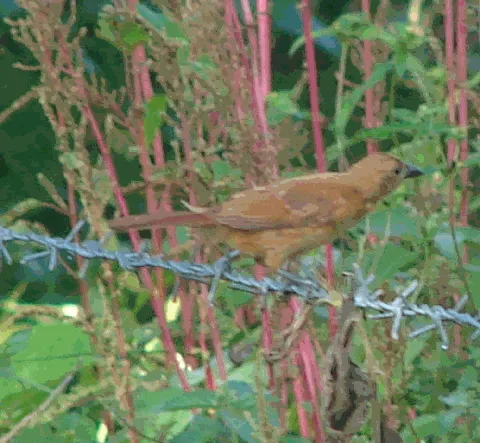 White-lined Tanager White-lined Tanager (Tachyphonus rufus) [order] PASSERIFORMES | [family] Thraupidae | [latin] Tachyphonus rufus | [UK] White-lined Tanager | [FR] Tangara noir lustre | [DE] Schwarztangare | [ES] Frutero Chocolatero | [NL] Zwarte Tangare SubspeciesMonotypic species Physical charateristicsThe White-lined Tanager is sexually dimorphic, the male being entirely black exceptf or a white shoulderp atch and the femalea uniform rufous brown. White-lined Tanagers are 18.5cm long and weigh 33g. They are long-tailed and with a mostly black stout pointed bill. The adult male is glossy black, apart from white underwing coverts and a small white patch on the upperwing. These white areas are conspicuous in flight but otherwise rarely visible. Females and immatures are entirely rufous in plumage, somewhat paler below. Listen to the sound of White-lined Tanager [audio:http://www.aviflevoland.nl/sounddb/W/White-lined Tanager.mp3]
RangeLatin America : Costa Rica to Northeast Argentina HabitatThe White-Lined Tanager is found primarily in forest borders, shrubby clearings and cultivated areas. It occurs in semi-open areas including gardens. ReproductionThe bulky cup nest is made out of grass and dead leafs and built in a tree or shrub low above ground. The female incubates three, sometimes two, brown-blotched cream eggs for 14-15 days. Feeding habitsThe White-Lined Tanager mostly moves about in pairs and seldom mixes with other species. They appear to be shy remaining quite low and rarely perch out in the open for very long. These are restless but unwary birds which eat a wide variety of fruit, but especially epiphytes. They also take some nectar and insects, including beetles, ants and grasshoppers. They appear to be territorial, as only one nesting pair is usually seen in an area. They feed at low levels and even on the ground. It sometimes feeds at army ant swarms, perching about a foot above the ground and pouncing down to the ground to take the insects flushed by the ants. It takes a fairly wide variety of fruits, showing a distinct preference for fruits of epiphytes. It also sucks honey from the flowers of trees. It searches for insects entirely in foliage, often rather thick foliage, where it flits swiftly about looking around, picking insects from leaves, and making fluttering sallies after insects it disturbed. ConservationThis species has an extremely large range, and hence does not approach the thresholds for Vulnerable under the range size criterion (Extent of Occurrence <20,000 km2 combined with a declining or fluctuating range size, habitat extent/quality, or population size and a small number of locations or severe fragmentation). The population trend appears to be stable, and hence the species does not approach the thresholds for Vulnerable under the population trend criterion (>30% decline over ten years or three generations). The population size has not been quantified, but it is not believed to approach the thresholds for Vulnerable under the population size criterion (<10,000 mature individuals with a continuing decline estimated to be >10% in ten years or three generations, or with a specified population structure). For these reasons the species is evaluated as Least Concern.  MigrationSedentary throughout range Distribution map |
]]>
